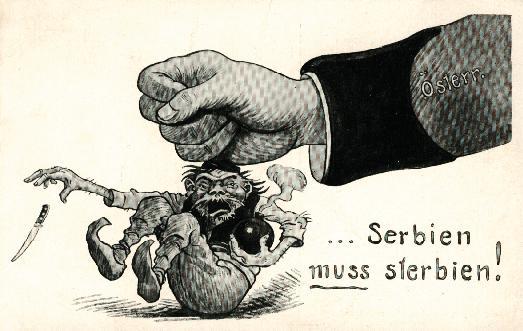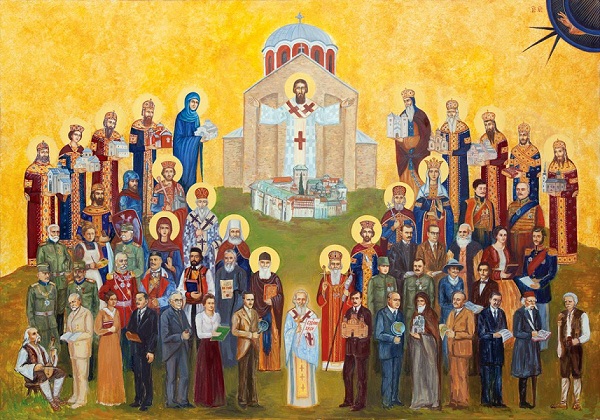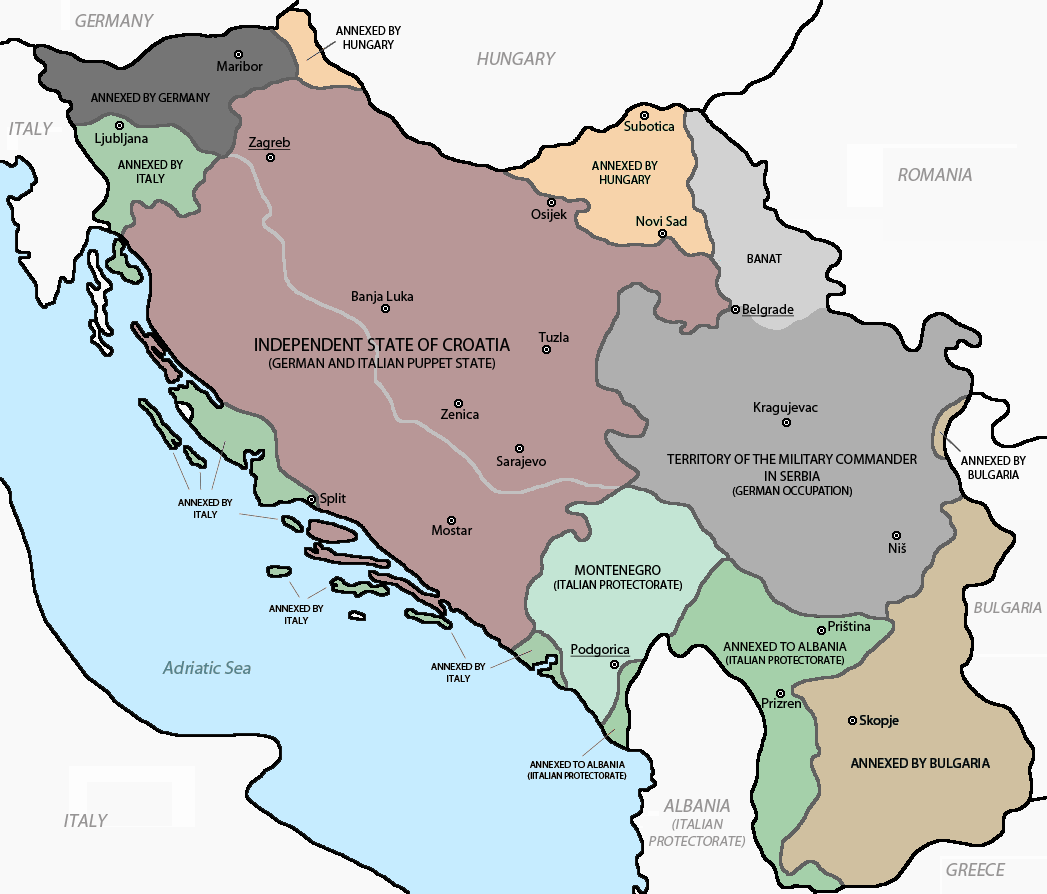|
Branko Dobrosavljević
Branko Dobrosavljević (Serbian Cyrillic: Бранко Добросављевић; 4 January 1886 — 7 May 1941) was a Serbian Orthodox priest who was killed by the Ustaše during the Genocide of Serbs in the Independent State of Croatia in World War II. Biography Branko Dobrosavljević was born in the village of Skrad, near Vojnić on 4 January 1886. He completed his high school education as well as the School of Theology at the Seminary in Sremski Karlovci in 1908. He married before he was ordained deacon on 15 March and elevated to presbyter on 22 March 1909. He carried out his clerical tasks in the villages of Buhača, Radovica and Veljun and received the Order of Saint Sava and Order of the Yugoslav Crown of the Fifth Degree for his services to his people. On the Feast of St. George, 6 May 1941, the very day of his own Slava Dobrosavljević was arrested by the Ustaše, headed by Ivan Sajfor from Veljun. Dobrosavljević's son was also arrested along with the paris ... [...More Info...] [...Related Items...] OR: [Wikipedia] [Google] [Baidu] |
Old Style And New Style Dates
Old Style (O.S.) and New Style (N.S.) indicate dating systems before and after a calendar change, respectively. Usually, they refer to the change from the Julian calendar to the Gregorian calendar as enacted in various Europe, European countries between 1582 and 1923. In England, Wales, Ireland and British America, Britain's American colonies, there were two calendar changes, both in 1752. The first adjusted the start of a new year from 25 March (Lady Day, the Feast of the Annunciation) to 1 January, a change which Scotland had made in 1600. The second discarded the Julian calendar in favour of the Gregorian calendar, skipping 11 days in the month of September to do so.. "Before 1752, parish registers, in addition to a new year heading after 24th March showing, for example '1733', had another heading at the end of the following December indicating '1733/4'. This showed where the Historical Year 1734 started even though the Civil Year 1733 continued until 24th March. ... We as h ... [...More Info...] [...Related Items...] OR: [Wikipedia] [Google] [Baidu] |
Order Of Saint Sava
The Order of St. Sava () is an ecclesiastic decoration conferred by the Serbian Orthodox Church and a dynastic order presented by the house of Karađorđević. It was previously a Order (distinction), state order awarded by both the Kingdom of Serbia and the Kingdom of Serbs, Croats and Slovenes/Kingdom of Yugoslavia. The state order was awarded to nationals and foreigners for meritorious achievements in the field of religion, education, science and the arts as well as for social and relief work. It was abolished in 1945 with the proclamation of the People’s Federal Republic of Yugoslavia and the end of the monarchy, while continuing as a dynastic order, with appointments currently made by Alexander, Crown Prince of Yugoslavia. The ecclesiastic order is awarded to ecclesiastic and secular persons with special merits. History The Order of Saint Sava was established by Milan I of Serbia, four years after the country gained independence and its transformation from a Principality ... [...More Info...] [...Related Items...] OR: [Wikipedia] [Google] [Baidu] |
Serbian Saints Of The Eastern Orthodox Church
Serbian may refer to: * Pertaining to Serbia in Southeast Europe; in particular **Serbs, a South Slavic ethnic group native to the Balkans ** Serbian language ** Serbian culture **Demographics of Serbia, includes other ethnic groups within the country *Pertaining to other places **Serbia (other) **Sorbia (other) *Gabe Serbian (1977–2022), American musician See also * * * Sorbs * Old Serbian (other) Old Serbian may refer to: * someone or something related to the Old Serbia, a historical region * Old Serbian language, a general term for the pre-modern variants of Serbian language, including: ** the Serbian recension of Old Church Slavonic la ... {{Disambiguation Language and nationality disambiguation pages ... [...More Info...] [...Related Items...] OR: [Wikipedia] [Google] [Baidu] |
Persecution Of Serbs
Anti-Serb sentiment or Serbophobia ( sr-Cyrl-Latn, србофобија, srbofobija, separator=" / ") is a generally negative view of Serbs as an ethnic group. Historically it has been a basis for the persecution of ethnic Serbs. A distinctive form of anti-Serb sentiment is anti-Serbian sentiment, which can be defined as a generally negative view of Serbia as a nation-state for Serbs. Another form of anti-Serb sentiment is a generally negative view of Republika Srpska, the Serb-majority entity in Bosnia and Herzegovina. The best known historical proponent of anti-Serb sentiment was the 19th- and 20th-century Croatian Party of Rights. The most extreme elements of this party became the Ustaše in the Kingdom of Yugoslavia, a Croatian fascist organization that came to power during World War II and instituted racial laws that specifically targeted Serbs, Jews, Roma and dissidents. This culminated in the genocide of Serbs and members of other minority groups that lived in the Inde ... [...More Info...] [...Related Items...] OR: [Wikipedia] [Google] [Baidu] |
Serbs Of Croatia
The Serbs of Croatia ( sh-Cyrl-Latn, separator=" / ", Срби у Хрватској, Srbi u Hrvatskoj) or Croatian Serbs ( sh-Cyrl-Latn, separator=" / ", Хрватски Срби, Hrvatski Srbi) constitute the largest national minority in Croatia. The community is predominantly Eastern Orthodoxy in Croatia, Eastern Orthodox Christian by religion, as opposed to the Croats who are Catholic Church in Croatia, Catholic. In some regions of modern-day Croatia, mainly in southern Dalmatia, ethnic Serbs possibly have been present from the Early Middle Ages. Serbs from modern-day Serbia and Serbs of Bosnia and Herzegovina, Bosnia-Herzegovina started actively migrating to Croatia at a time when the Habsburg monarchy was engaged in a series of wars against the Ottoman Empire. Great Migrations of the Serbs, Several migration waves happened after 1538, when the Emperor Ferdinand I granted them the right to settle on the territory of the Military Frontier. In exchange for land and exempti ... [...More Info...] [...Related Items...] OR: [Wikipedia] [Google] [Baidu] |
People From Karlovac County
The term "the people" refers to the public or common mass of people of a polity. As such it is a concept of human rights law, international law as well as constitutional law, particularly used for claims of popular sovereignty. In contrast, a people is any plurality of persons considered as a whole. Used in politics and law, the term "a people" refers to the collective or community of an ethnic group or nation. Concepts Legal Chapter One, Article One of the Charter of the United Nations states that "peoples" have the right to self-determination. Though the mere status as peoples and the right to self-determination, as for example in the case of Indigenous peoples (''peoples'', as in all groups of indigenous people, not merely all indigenous persons as in ''indigenous people''), does not automatically provide for independent sovereignty and therefore secession. Indeed, judge Ivor Jennings identified the inherent problems in the right of "peoples" to self-determination, as i ... [...More Info...] [...Related Items...] OR: [Wikipedia] [Google] [Baidu] |
1941 Deaths
The Correlates of War project estimates this to be the deadliest year in human history in terms of conflict deaths, placing the death toll at 3.49 million. However, the Uppsala Conflict Data Program estimates that the subsequent year, 1942, was the deadliest such year. Death toll estimates for both 1941 and 1942 range from 2.28 to 7.71 million each. Events Below, the events of World War II have the "WWII" prefix. January * January– August – 10,072 men, women and children with mental and physical disabilities are asphyxiated with carbon monoxide in a gas chamber, at Hadamar Euthanasia Centre in Germany, in the first phase of mass killings under the Aktion T4 program here. * January 1 – Thailand's Prime Minister Plaek Phibunsongkhram decrees January 1 as the official start of the Thai solar calendar new year (thus the previous year that began April 1 had only 9 months). * January 3 – A decree (''Normalschrifterlass'') promulgated in Germany by Martin ... [...More Info...] [...Related Items...] OR: [Wikipedia] [Google] [Baidu] |
1886 Births
Events January * January 1 – Upper Burma is formally annexed to British Burma, following its conquest in the Third Anglo-Burmese War of November 1885. * January 5– 9 – Robert Louis Stevenson's novella '' Strange Case of Dr Jekyll and Mr Hyde'' is published in New York and London. * January 16 – A resolution is passed in the German Parliament to condemn the Prussian deportations, the politically motivated mass expulsion of ethnic Poles and Jews from Prussia, initiated by Otto von Bismarck. * January 18 – Modern field hockey is born with the formation of The Hockey Association in England. * January 29 – Karl Benz patents the first successful gasoline-driven automobile, the Benz Patent-Motorwagen (built in 1885). February * February 6– 9 – Seattle riot of 1886: Anti-Chinese sentiments result in riots in Seattle, Washington. * February 8 – The West End Riots following a popular meeting in Trafalgar Square, London. ... [...More Info...] [...Related Items...] OR: [Wikipedia] [Google] [Baidu] |
List Of Serbian Saints
This is a list of saints of the Serbian Orthodox Church. List The Serbian Orthodox Church (SOC) venerates all Eastern Orthodox saints, regardless of ethnic background (e.g. John the Baptist, Maximus the Greek and Nicholas II of Russia). However, this list specifically includes saints who were either of Serbian descent and/or members of the SOC (or one of its historical predecessors, e.g. Serbian Patriarchate of Peć). Listed below are only those officially recognised by the SOC. Folk saints not yet canonised by the Church (e.g. Patriarch Pavle, Milica Rakić and Thaddeus of Vitovnica) are not included. The list below provides each saint's name (typically the one given at the saint's canonisation) in English, Serbian Cyrillic and Latin, year of death, feast day (on both the Julian calendar and Revised Julian calendar), saint titles and notes on the saint's notable actions, other names and relations with other saints. An icon or photograph is also provided if available. ... [...More Info...] [...Related Items...] OR: [Wikipedia] [Google] [Baidu] |
Julian Calendar
The Julian calendar is a solar calendar of 365 days in every year with an additional leap day every fourth year (without exception). The Julian calendar is still used as a religious calendar in parts of the Eastern Orthodox Church and in parts of Oriental Orthodox Churches, Oriental Orthodoxy as well as by the Amazigh, Amazigh people (also known as the Berbers). The Julian calendar was proposed in 46 BC by (and takes its name from) Julius Caesar, as a reform of the earlier Roman calendar, which was largely a lunisolar calendar, lunisolar one. It took effect on , by his edict. Caesar's calendar became the predominant calendar in the Roman Empire and subsequently most of the Western world for more than 1,600 years, until 1582 when Pope Gregory XIII promulgated a revised calendar. Ancient Romans typically designated years by the names of ruling consuls; the ''Anno Domini'' system of numbering years was not devised until 525, and became widespread in Europe in the eighth cent ... [...More Info...] [...Related Items...] OR: [Wikipedia] [Google] [Baidu] |
Otočac
Otočac () is a town in Croatia, former bishopric and present Latin Catholic titular see. It lies in the northwestern part of Lika region, in the Gacka river valley. The population of the administrative area of the Town of Otočac was 9,778 in 2011, with 4,240 in Otočac itself, the majority of whom were Croats (91%). Name The town is known as ''Otocsán'' in Hungarian, ''Ottocio'' in Italian, and ''Ottocium'' in Latin. In historical sources, the name has been rendered as ''Ottochaz'' (German and English), ''Ottocaz'' (Italian and German), and ''Ottotschaz'', ''Ottotschan'', & ''Ottocsaz'' (German). History Otočac was named after the early Croatian parish. The text of the famous Baška Tablet (around 1100) says that the church of St. Nicholas in Otočac was part of the order community with the Church of St. Lucy, Jurandvor on the island of Krk. From 1300 on, it belonged to the estate of the Frankopan family. Sigismund Frankopan (1461–1535) founded a diocese there (see be ... [...More Info...] [...Related Items...] OR: [Wikipedia] [Google] [Baidu] |
Blagaj Massacre
The Blagaj massacre was the mass killing of around 400 Serb civilians by the Croatian nationalist Ustaše movement on 9 May 1941, during World War II. The massacre occurred shortly after the German-led Axis invasion of Yugoslavia and the establishment of the Ustaše-led Axis puppet state known as the Independent State of Croatia (NDH). It was the second act of mass murder committed by the Ustaše upon coming to power and was part of a wider campaign of genocide against Serbs in the NDH that would last until the end of the war. The victims were drawn from the village of Veljun and its surroundings, ostensibly for their involvement in the robbery and murder of a local Croat Catholic miller, Joso Mravunac, and his family. The Ustaše claimed that the murders were ethnically motivated and signalled the start of a regional Serb uprising. Following their arrests, the prisoners were detained in a Blagaj school, where many were beaten and tortured. The Ustaše intended to organize a ma ... [...More Info...] [...Related Items...] OR: [Wikipedia] [Google] [Baidu] |






